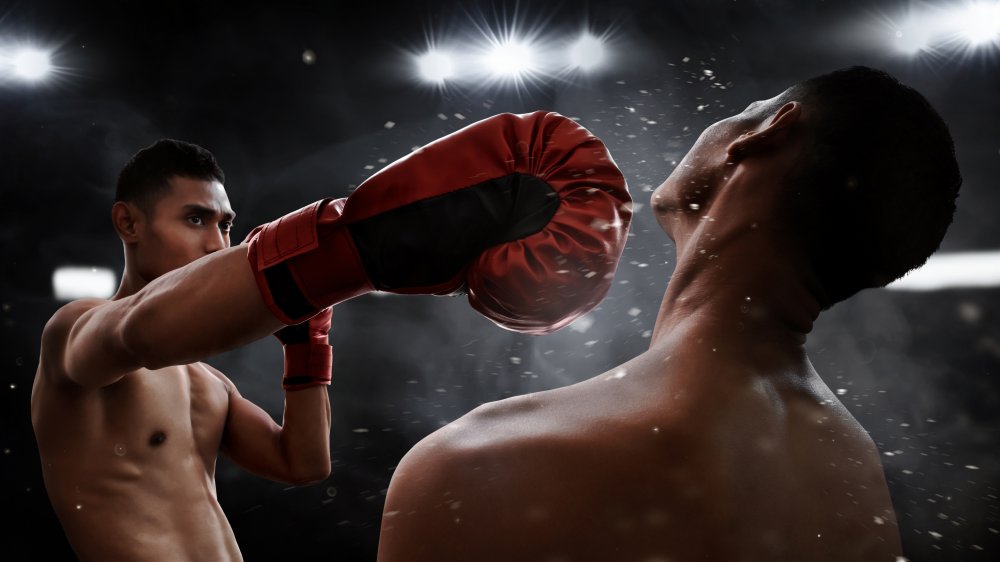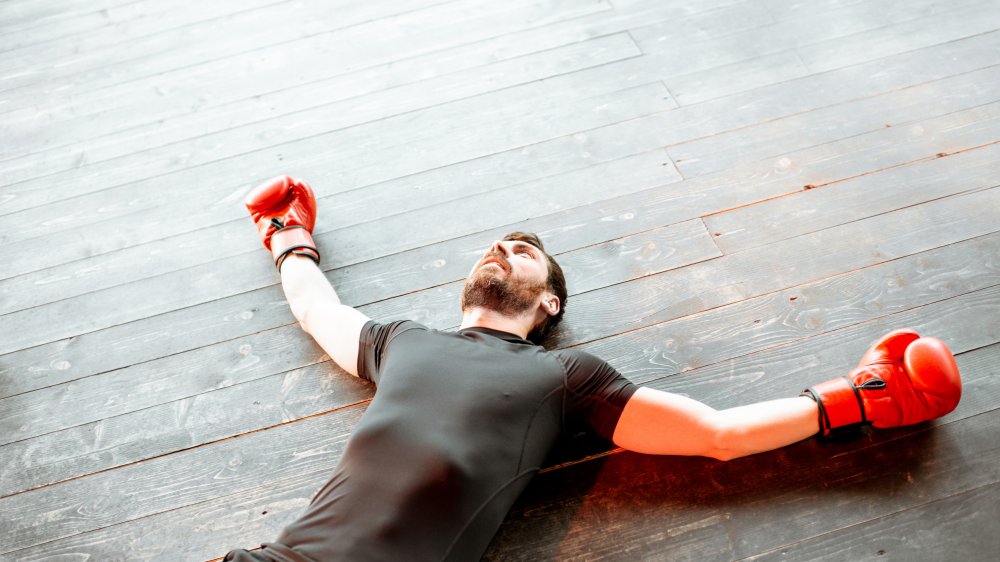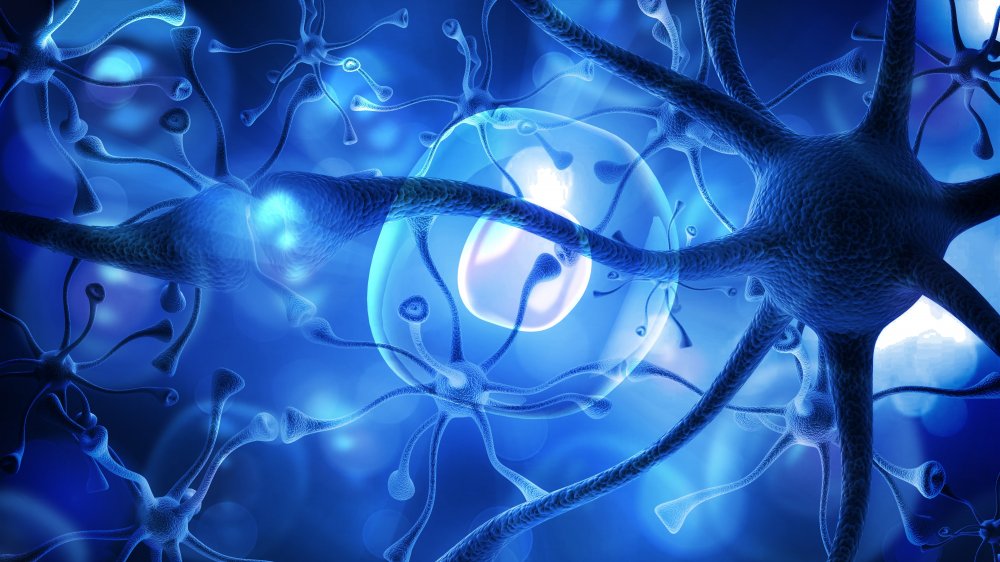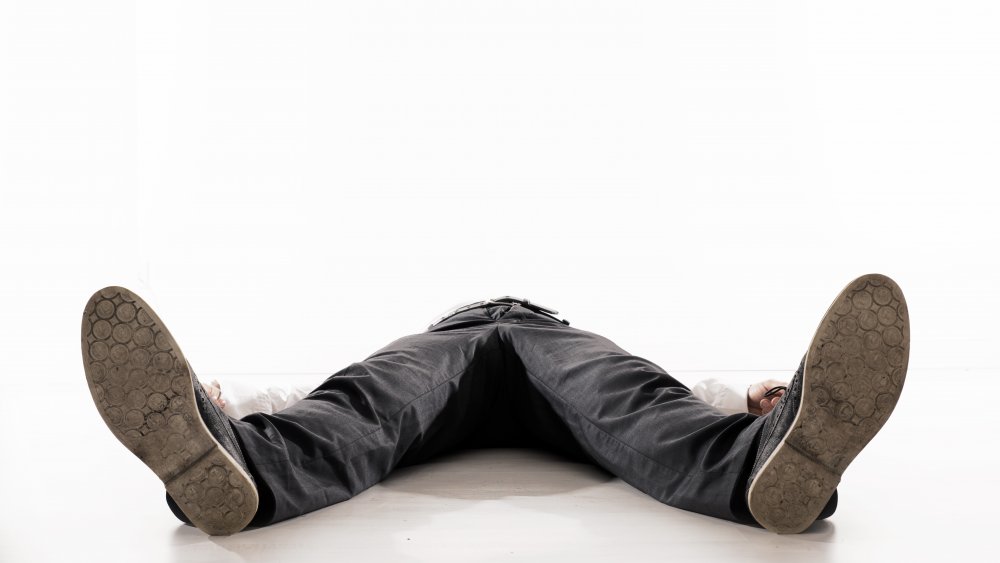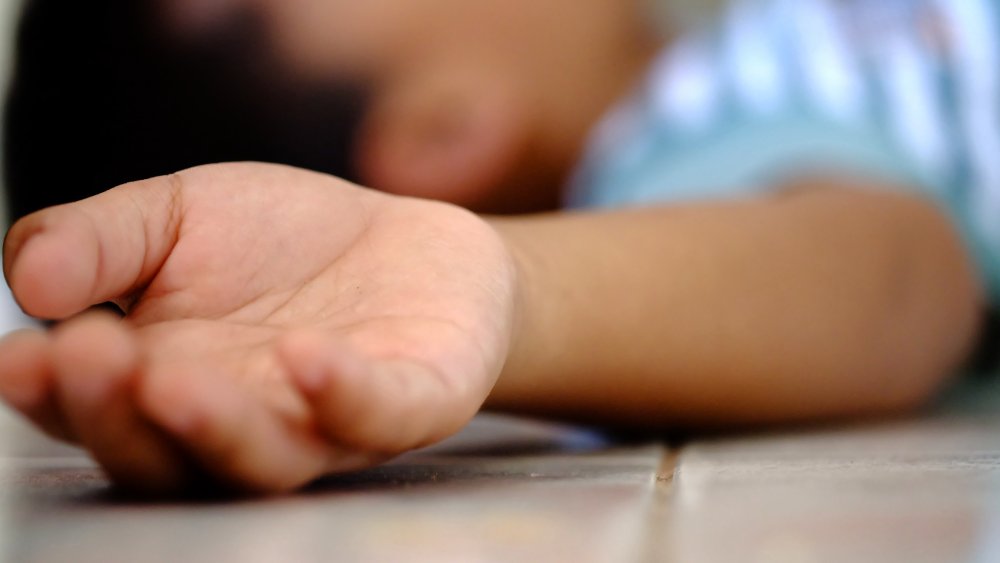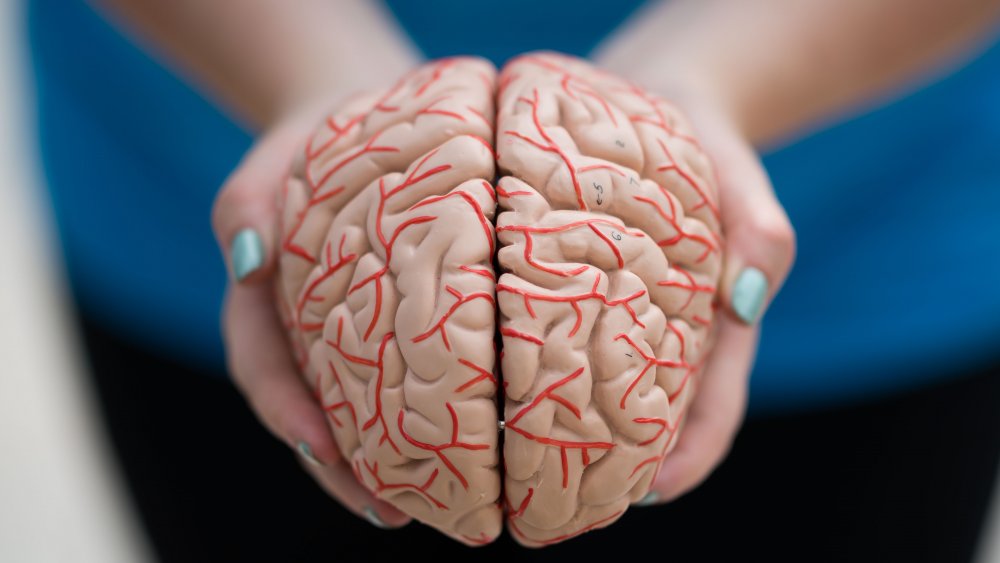What Happens To Your Body When You Get Knocked Out
You'll often see characters getting knocked out in films, but what you see in movies isn't an accurate representation of what happens when someone's knocked unconscious. Villains are knocked out with a single hit, presumably never to rise again, while heroes may be knocked out from a single punch to the head for several hours, though they're absolutely fine when they regain consciousness.
In real life, being knocked out has many repercussions, both physical and mental. Whether they're short-term effects like trouble with memory or headaches or long-term cognitive issues, even just a single knockout can have effects on the body. Despite this, many sports encourage knockouts, like boxing or MMA fighting, while other sports consider knockouts an unavoidable aspect of the game, like soccer or American football.
Losing consciousness for any amount of time is, by definition, a traumatic brain injury, though such an injury doesn't require a loss of consciousness. Being knocked out occurs when particular parts of the brain are affected from a blow to the head, and it should always be treated as serious, whether you're unconscious for five seconds or five minutes. Here's what happens to your body when you get knocked out.
What does it mean to be knocked out?
The expression "being knocked out" refers to when someone is knocked unconscious from a blow to the head or from striking one's head against an object. These types of trauma are distinguished as acceleration and deceleration, respectively, though their end result on the brain is comparable.
Knockouts occur most often in combat sports, where it is often an essential part of winning the match, though they happen in a variety of other sports. In MMA fighting, there are various types of knockouts such as a typical, a flash, or a stunning knockout. A flash knockout is considered a fan favorite, occurring when the opponent is leveled by a single hit. Despite the fact that being knocked out is part of sporting, the act itself is pretty detrimental to the brain.
According to Head Injury Symptoms, being knocked out is the result of a mild traumatic brain injury, lasting anywhere from a few seconds to 10 minutes, depending on the severity of the blow. Traumatic brain injuries range from mild to moderate to severe, and while the brain might look normal under MRI and CAT scans, being knocked out often has lingering cognitive effects. Even if someone wakes up relatively quickly and seems fine after being knocked out, up to 15 percent of people show symptoms of mild traumatic brain injury up to a year or more after the initial injury.
What happens outside the brain when you're knocked out
When hit, the brain suffers from a rapid acceleration caused by the punch and then a rapid deceleration as muscles, tendons, and cerebrospinal fluid try to keep the brain from slamming into the inside of the skull.
According to Scientific American, as the brain flies in one direction, it twists along the brain stem since the head is moving compared to the inertia of the body. Along with the movement of the brain inside the skull, this twisting of the brain affects the reticular formation, cutting off effective signaling, resulting in a loss of consciousness. The reticular formation consists of many neural networks, including those of sleep and consciousness, so if there's a disruption to the normal pathways of the nerves, signals for consciousness won't get through.
A knockout can also occur when the cerebral sinuses are jolted from a hit to the jaw. Cerebral sinuses control the flow of oxygen and blood to the brain, and a lapse in regulation can cause enough of a decrease in flow to result in a loss of consciousness. As a result of the blow to the head, the brain suffers damage at two points, known as the coup and contrecoup. The coup is where the brain hits the skull at the point of impact from the blow, and the contrecoup is the opposite side of the skull from the point of impact where the brain also takes a hit during deceleration.
What happens inside the brain when you're knocked out
As the brain is being battered and twisted about, neurotransmitters begin firing signals simultaneously in reaction to the trauma. At a cellular level, nerves begin leaking potassium ions as calcium ions rush in, an exchange which destabilizes the electrolyte balance in the brain cells. The introduction of calcium also causes the blood vessels to constrict, which leads to a decrease in blood flow within the brain. Until that balance is restored, neurons can't function properly.
According to the Chicago Tribune, too much calcium hinders the function of the mitochondria, the powerhouse of the cell, as it disrupts blood flow. This makes it increasingly difficult for cells to get the potassium they need in order to rebalance themselves. While calcium is essential for a properly functional nervous system, if there's too much of an influx of calcium, it can lead to cell death.
However, cell death isn't an immediate effect, and if the person avoids further trauma, brain cells are able to slowly rebalance themselves. But the recovery is not immediate, and the effects of calcium gumming up the neurons lead to various concussion symptoms such as nausea and dizzy spells.
The fencing response
In the event of a traumatic brain injury, the body undergoes what is known as the fencing response. According to Heathline, it's an unnatural position of the arms that occurs after impact and persists up to several seconds, even when the person has fallen to the ground. The name comes from its similarity to the fencing reflex in newborns, also known as the asymmetrical tonic neck reflex
While the fencing response doesn't always occur with a traumatic brain injury, it's often a good indicator that such an injury has occurred, since it occurs in almost two thirds of instances, according to Ario Hosseini and Jonathan Lifshitz, researchers from the Spinal Cord and Brain Injury Center at the University of Kentucky.
They were able to identify the fencing response through the help of YouTube videos. After noting the fencing response's prevalence in knockout videos, they found through their research that the fencing response is associated with a blow to the brain stem. When blood vessels rupture from a blow to the head, their leaking contents activate the lateral vestibular nucleus, a part of the brain stem that controls motor and antigravity muscles, leading to the characteristic stiffening and extension of the arms. Hosseini and Lifshitz also concluded that the fencing response occurs as a result of moderate traumatic brain injury rather than mild traumatic brain injury, which is why a knockout may not always be accompanied by the fencing response.
Knockouts vs. concussions
While most knockouts are usually accompanied by a concussion, and most concussions are accompanied by a blow to the head, it's a common myth that a concussion necessitates a loss of consciousness. While they are similar and related to one another, they are not synonymous. It's a little bit like squares and rectangles — a square is a rectangle, but a rectangle is not always a square. Knockouts are concussions, but a concussion is not always a knockout. A concussion is instead characterized by any sort of temporary loss of normal brain function, which includes a loss of consciousness but is not limited to it.
According to the CDC, a concussion falls into the category of traumatic brain injuries that occur as a result of the brain's sudden jostling in the skull. There was once the assumption that a concussion was always accompanied with a loss of consciousness, but according to the American Association of Neurological Surgeons, in most cases, this is not true, and there's actually no loss of consciousness. Many of the neurological effects of a concussion occur along with the event of being knocked out, but being knocked out necessitates a loss of consciousness, whereas a concussion reflects on brain activity in general. And even without losing consciousness, depending on the level of injury sustained by the brain, recovery from a concussion can range from a few days to several weeks.
How boxing gloves didn't really make things better
According to the Washington Examiner, bare-knuckle boxing is actually safer than boxing with gloves. Boxing gloves were introduced into the sport in order to protect boxers' hands, but as a result, boxers were able to hit even harder without feeling the impact on their own hands. With bare-knuckle boxing, boxers wouldn't throw the hardest punch possible because of the risk of injury to their hands. Since boxers especially wouldn't risk a headshot for fear of a broken hand, matches could last up to 30 rounds.
Once boxers started fighting with boxing gloves, they could hit harder without risk of injury, and they wouldn't feel the impact of their own blows as much, which allowed them to deliver repeated strikes. This led to an increase of injuries in the ring, especially head injuries, despite the fact that the boxing gloves were introduced with the intention of decreasing injuries. With gloves, boxers were more willing to strike blows to the head, leading to an increase in the number of knockouts, as well as the number of concussions among boxers.
So what does a helmet do?
Since a blow to the head can result in a great deal of damage, one would think that helmets should work to prevent that sort of thing. But, in fact, helmets are actually only useful for preventing skull fractures rather than internal injuries from a blow to the head. According to Scientific American, this is why American football players continue to suffer from trauma and recurrent concussions. American football helmets have evolved as concussion concerns persisted, but the helmets continue to protect more against skull fractures than concussions.
While a helmet protects a head from rough surfaces and distributes the force of blows, it doesn't provide support to the brain itself to keep it from rocking back and forth in the skull. So while a helmet can prevent a skull from cracking, the brain itself is still vulnerable to concussions, despite the appearance of safety that a helmet may provide.
According to Science Daily, if a helmet is fitted properly to a player, it may decrease the severity of a concussion, but there's still no technology to completely prevent them. However, since helmets often prevent the head from twisting too much, there's somewhat of a decreased chance of loss of consciousness as a result of torque on the brain stem.
How long you're knocked out for
The length of time that a person is knocked out for typically depends on the severity of the traumatic brain injury. According to Headway, if someone is unconscious for less than 15 minutes, their traumatic brain injury is considered to be mild. A loss of consciousness between 15 minutes and six hours is considered a moderate traumatic brain injury, and between six hours and 48 hours is severe traumatic brain injury. And the longer that a person is unconscious, the longer their post-traumatic amnesia will last, as well.
Post-traumatic amnesia can occur without a person having been unconscious, but it commonly happens when consciousness is lost due to brain injury. As a result, after regaining consciousness, people suffer from a state of confusion and disorientation that can last upwards of seven days in the case of severe traumatic brain injuries.
In general, most knockouts should last between 30 and 120 seconds. The longer that someone is knocked out, the higher the risk of internal bleeding, cell death, and brain damage, with those risks rising exponentially as time goes on. If someone is unconscious for several hours, surgery may end up being required to relieve pressure on the brain.
Short-term effects of being knocked out
Even being knocked out for just a couple of seconds can have short-term cognitive effects, since any disruption in brain function is already a concussion by definition. According to the Mayo Clinic, short-term physical effects can include headaches, nausea, fatigue, difficulty with speech, and dizziness, while cognitive effects can include memory problems and mood swings. These effects can last from several hours to several days. In the end, over 80 percent of people who have sustained a mild traumatic brain injury will have a speedy recovery with few to no long-term effects.
However, this doesn't mean that someone can bounce back immediately after being knocked unconscious. When an athlete is knocked unconscious, medics turn to the Glasgow Coma Scale (GCS) or the Sport Concussion Assessment Tool (Scat) in order to determine how severe the head injury is, but according to the BBC, these brief on-field inspections can miss injuries that aren't readily apparent. This is especially of concern because there might be bleeding or brain swelling that can lead to long-term damage if not treated immediately. Even if someone will be alright 95 percent of the time, it often takes several hours to assess for all signs of damage, so it's an unnecessary risk not to take any amount of loss of consciousness seriously.
Long-term effects of being knocked out
Even a single traumatic brain injury can have lifelong physical, cognitive, and behavioral effects. While symptoms of a mild traumatic brain injury typically resolve within six weeks, anything that lasts longer is considered a long-term effect, or post-concussion syndrome.
When there's a blow to the head that causes a loss of consciousness, it's accompanied by a loss of brain tissue that can lead to a variety of neurological conditions, according to Reuters. Since the tissue lost is often part of the frontal and posterior brain regions, as well as white matter, the brain loses its communication network, which inhibits its ability to efficiently process. Even a loss of five percent can have a substantial effect on behavior. There have also been recorded instances of emotional changes, as well as shortened life spans. Roughly 20 percent of those who've experienced a mild traumatic brain injury will suffer from long-term effects, although some research suggests that it might be as many as 50 percent. These effects include trouble concentrating, memory problems, depression, anxiety, trouble with smell and taste, and sleep disturbances.
According to a study published in Molecular and Cellular Neuroscience, one concussion is associated with a 22- to 26-percent increase in the risk of dementia. Another study published in Neurosurgery suggests that even a single traumatic brain injury can result in neurodegeneration. And in 2013, the American Association for the Advancement of Science presented research that showed brain damage lasting and appearing on brain scans years after the original injury.
Repeatedly being knocked out
If someone repeatedly experiences blows to the head that result in a loss of consciousness, the risk of neurological damage is compounded. Repeatedly losing consciousness also means that the brain sustains multiple blows — and multiple parts of the brain sustain damage, which can result in a variety of neurological conditions as more areas of the brain experience cell death. Since a blow to the head that causes a loss of consciousness inevitably results in a loss of brain tissue, repeatedly being knocked out leads to more and more brain tissue death.
According to the Queensland Brain Institute, repeated concussions are linked to increased risk of neurodegenerative diseases such as Alzheimer's, Parkinson's, and Chronic Traumatic Encephalopathy (CTE). As indicated by a study of retired professional American football players, there's also an increased risk of depression. Players with at least one concussion in their history were 1.5 times more likely to suffer from depression, while those with three or more were three times more likely to suffer from depression.
